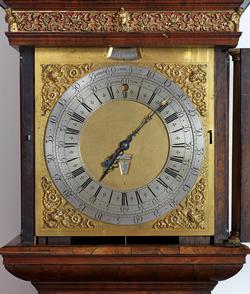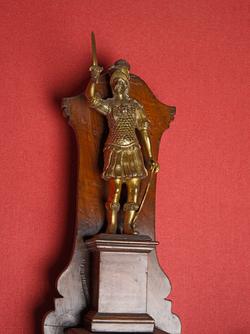Current Location: Gallery 17 (Flower)
Titles
The Drayton House Clock
Maker(s)
Maker of movement:
Tompion, Thomas
Entities
Categories
Description
Oak case with burr walnut veneer, pierced and cast ormolu mounts, including urns and a Roman warrior. Below the dial is an opening showing the days of the week with their deities. Above the chapter ring openings display an annual calendar and the sun's position in the ecliptic, its apparent annual path through the heavens. The movement is of year duration.
Dial: Dial plate 12 inches by 16 7/8 inches high, with spandrels and chapter ring within an engraved line 11 1/4 inches square. Silvered chapter ring engraved I-XII twice and 5-60 twice with minute and half minute divisions outside the minute numbers and half hour divisions on the inner edge. The chapter ring engraved near the top with ‘EQUAL TIME' and with fleur de lys type half hour marks. It is mounted on the matted dial centre which is supported on three dial feet independently of the dial plate. Surrounding the chapter ring is a rotating minute ring with divisions and numbers as on the chapter ring and inscribed at the top ‘APPARET TIME'. The spandrels are of a cherub and flower design (Cescinsky & Webster, No.7) introduced by Tompion and used mainly by him. Between the spandrels fine scrolling foliage is engraved and at the lower edge ‘THO. TOMPION.LONDON.INVENT.' Curved openings below the dial centre show the days of the week, each with its appropriate deity. Similar openings above the chapter ring display an annual calendar and the sun's position in the zodiac. Finely pierced steel hands, the minute hand being accurately balanced and having a gilt tip to point to apparent time.
Movement: The year timepiece movement has no seat board but rests directly on metal plates on the tops of the reinforced sides of the case. The movement is inverted, with the escapement at the bottom, and is made in two sections with the barrel assembly and the second wheel in a small frame to the rear. The remainder of the train and all the calendar and equation work are mounted on the large front plate. Bolt and shutter maintaining power is fitted to protect the delicate escapement and is operated by a lever on the right hand side of the dial. The equation cam, on the same arbor as the annual calendar, is driven by a vertical arbor from the motion work. A bell crank which follows the cam carries a rack which engages with a wheel at the centre of the apparent time ring and moves it backwards or forwards as required.
Case: Has an oak carcase veneered with burr walnut and with narrow herring-bone bandings. The skirting appears to be original. The case has a rising hood, originally without a door and with acanthus design side frets of walnut veneer. The very elaborate superstructure appears to be of slightly different carcase wood and to be slightly later in date than the rest of the hood. A disturbing feature of the case is that, with the hood door closed, both calendar and zodiac slots are covered and when the door is opened only the calendar slot is visible. Arising from a consideration of these peculiarities it is suggested that the hood, originally without a door, had only a modest-sized superstructure. Traces remain of the spoon lock for securing the hood and the catch for holding it in the raised position. The hood would have had to be raised for winding or adjusting the clock when both calendar and zodiac slots would have been visible. It is quite probable that the original customer wanted a more imposing clock in keeping with a lofty room and the large caddy top with its elaborate mounts was then provided. The hood thus became too unwieldy to raise for winding or setting the clock so a door was made.
The trunk door has its original iron lock and hinges, exceptionally three in number. The remain¬ing mounts are of gilt brass and include fine vase and urn finials, a central figure of a warrior, probably Mars, and fine repoussé frieze frets consisting of strapwork and of floral scrolls wtih central female mask and cherub heads at the corners. Like other special clocks the trunk door has tiny metal spandrels in the corners. The `gothic' shaped metal frame to the pendulum window is also used on the William III clock mentioned belowand resembles a design by David Marot.
Notes
History note: Said to have been supplied by Tompion to Drayton House, home of Lady Mary Mordaunt, Duchess of Norfolk after her separation from the Duke in 1692. It remained there until 1928 when it was acquired by Francis P. Garvan; J.S. Sykes; S.E. Prestige.
Legal notes
Given by S.E. Prestige, through the National Art Collections Fund.
Measurements and weight
Height: 262.2 cm
Height: 2642 cm
Height: 8'8" ft
Acquisition and important dates
Method of acquisition: Given
(1947)
by
Prestige, Sidney Ernest
Dating
17th Century, Late
William III (1650-1702)
Circa
1695
CE
-
Circa
1700
CE
Note
It is instructive to compare this clock with the year equation clock made for William III and dated c.1695 (see Symonds, figs. 22, 23, 64). This has a small break arch to expose the calendar and zodiac slots and its rising hood is also cut for a door. Apart from the upper parts of the hoods the cases are virtually identical.
This clock is said to have been supplied by Tompion to Drayton House, which Lady Mary Mordaunt, Duchess of Norfolk inherited from her father in 1697. Lady Mary had separated from the Duke of Norfolk and formed a liason with Sir John Germane, whom she married after being divorced from the Duke in 1700. She died in 1705. In 1718 when Sir John died, the house was inherited by his second wife, Lady Betty Germaine. An inventory of the contents of Drayton House taken in 1710 mentions 'In the Great Hall itself . . . One Clock', and an inventory of 1724 mentions 'No. 36 In the great Hall . . . 1 large clock', which might have referred to this one.
School or Style
Baroque
People, subjects and objects depicted
Components of the work
Veneer
composed of
walnut
Materials used in production
Oak
Techniques used in production
Piercing
Veneering
Inscription or legends present
- Text: THO.TOMPION. LONDON.INVENT
- Location: At bottom of dial
- Method of creation: Engraved
- Type: Name
References and bibliographic entries
Identification numbers
Accession number: M.22-1947
Primary reference Number: 95862
Stable URI
Audit data
Created: Saturday 6 August 2011
Updated: Monday 25 March 2024
Last processed: Wednesday 17 September 2025
Associated departments & institutions
Owner or interested party:
The Fitzwilliam Museum
Associated department:
Applied Arts









